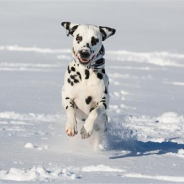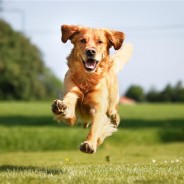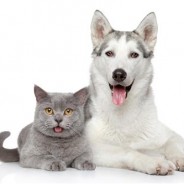Blog
How to Care for Cats in the Winter
Like humans, cats are prone to become sick of the indoors over the winter season. They may venture out the cat door every now and then, but they can’t wait for spring any more than you can. Even if your cat is normally an indoor cat, there are some adjustments you can make so that your kitty has a more pleasant winter than they might otherwise have. It doesn’t take much effort, and it can make both you and your cat happier during the cold season.
Groom Frequently
Cats tend to put on an extra layer of fur during the cold season, which helps them stay warm inside and outside....
read moreWinter Exercises for Dogs
The cold season means that both you and your pet are indoors more often, but don’t rely on the dog door to be the only means by which your dog sees the outdoors or gets exercise. Remember that fresh air and exposure to sunlight has numerous benefits for both you and your pet. Of course, it’s also a great idea to plan some indoor exercises as well, for those days when it’s just not sensible to be outside.
Practice Scent Training
This is an exercise you can do both inside and outside. Let your dog sniff something, and then hide it and encourage your pup to find it. Make...
read moreGrooming Pets in the Winter Season
The winter season might make you extra grateful for your dog door, but how is your dog feeling about it? Cold weather brings some added issues for dogs, issues that not every pet owner realizes. From nail trimming to brushing the coat a little more often, it’s important to put a little more focus on grooming your pets when it is cold outside, especially if you live in an area that sees any kind of snowfall. Use the tips below to help your dog enjoy the winter season this year.
Take Care of the Coat
Many people think that you can’t trim a dog’s coat in the winter. If your dog is...
read moreFun Ways to Exercise Your Dog
We all love our dogs, but, let’s face it, sometimes we’re a bit apt to overindulge them. Couple that with the fact our lives are always busy, and it can make for an unhealthy dog. If your dog doesn’t have a pet door so he or she can get outside during the day, these fun exercises will help you both get the exercise you need.
Doggy Tag
Just as you may have played tag as a child, you can play this great game with your dog. Head out to the local dog park or to the backyard and teach your dog this game. Together you can both get some great cardio.
The Oldie But Goodie – Fetch
This one has been around through the ages. Find a stick or grab a toy, and get in some dog training and exercise all...
read moreHow to Keep Your Pets Warm in Cold Weather
With winter on the way, remember that cold weather can have a serious effect on pets. It’s best to place dogs and cats indoors for the majority of the season, except for necessary exercise. Before you head outside for playtime with your pet, follow these tips to keep them warm.
Provide Shelter
The best way to protect your dog or cat during the winter months is to bring them inside – period. You should never leave your pet outside for extended periods of time without supervision, especially if there’s a chance of inclement weather.
However, if your dog or cat has grown accustomed to spending much of the day outdoors, there are measures you can take to ensure he’s safe in colder weather. Shop for or build your own draft-free shelter using scrap lumber...
read moreTips for Understanding Your Dog’s Behavior
Though they can’t vocalize their feelings, dogs use behavior and posture to give us clues about different states of mind. Watch your dog’s body language to gauge his mood; taking into account how he holds himself, the motion of his tail, and even the way his head is positioned.
Posture
A dog’s standing position can tell us many things about how he’s feeling:
- Standing At-Ease: You’ll know when your dog is content by the way he stands. A loose standing position is a sign of relaxation and calm. If he’s feeling especially cheerful, he may even wag his tail.
- Cowering: A dog that holds his body close to the ground, shoulders lowered, is the sign of a submissive mood. This is your pet’s way of giving dominance to you or... read more
Ways Your Dog Shows Love
From a friendly lick to fast-paced tail wagging, there are many ways that our canine companions exhibit love. Since dogs can’t come right out and tell us how they feel, here are a few telltale signs your pup is expressing emotions of loyalty and happiness:
- Tail Wagging: Dogs use their tails to express many different emotions, from fear to excitement. You can tell your dog is happy to see you when his tail is wagging so hard that his behind sweeps from side to side. You may even see his tail move in circles! Next time you come home to your pup after a long day at work, watch his tail to see his love for you.
- Licking: Like wagging, there are many different reasons that dogs lick. Puppies use licking to indicate to their mother that they’re ready to... read more
How to Make Homemade Dog Food
Wsith recent consumer trends favoring a move to conscious, sustainably-sourced cuiine, food for pets seems to be following a similar trajectory, especially since many packaged feeds often contain insufficient nutrients, high levels of fat, and low-quality fillers. Due to overwhelming feed options on the market, now more than ever consumers have pledged to make their own quality dog food from scratch. Here is everything you need to get started.
The Essentials
A balanced diet is crucial to keep your pet happy and healthy. Make sure your homemade dog food includes these important nutrients:
- Fat and Fatty Acids: Try using eggs, meat, and added oil to give your pup the fatty acids he needs.
- Quality Protein: A dog’s active lifestyle... read more
Top Dog Breeds for Longevity
On average, your pooch is expected to live anywhere between five and sixteen years of age. Though factors like health and lifestyle can affect the longevity of your pet, breed size is often considered the most reliable method of lifespan estimation. Larger dog breeds tend to live only a fraction as long as small dogs do. Though it’s difficult to predict how long your pet will live, here is a list of breeds that are known for having lengthy lives:
- Corgi: This compact breed is intelligent and friendly, making the perfect pet for any family. Corgis are also known to live as old as twelve to fifteen years, which means you have lots of time for making memories together.
- Pomeranian: Frisky and confident, Poms pack a lot of character into their... read more
Ways to Tell Your Pet Is Happy
Like humans, animals are also capable of expressing a range of emotions. Although they can’t use words to say how they’re feeling, dogs and cats wield body language and physical cues that show what’s going on inside their minds. From purring to smiling, here are some of the ways you can understand your pet’s demeanor.
Cheerful Canines
Here is how to tell when your pup is feeling relaxed and happy:
- Tail Movement: Wagging is a telltale sign that your dog is feeling loved. The way a dog moves his tail can display a range of emotions, too. A relaxed and calm dog will hold his tail in the natural position, but a pup that’s feeling excited may move his tail briskly from side to side. The faster the wag, the happier the dog: you might see his... read more








